 BLOG
BLOG
READING 5min
Retrofit in Scotland: new research by Novoville
24-02-2023
BY LOUIS DAILLENCOURT

Novoville has just released new research about homeowners' education and readiness to retrofit and decarbonise.
This research was conducted as part of the development of the tech company’s innovative solution to CivTech Challenge 7.7 (“How can technology help communities and households understand their energy needs and work with local suppliers towards sustainable energy solutions?”) carried out in partnership with South of Scotland enterprise. Novoville would like to thank their partners EALA Impacts , Loco Home and Everything Is User Experience for their help.
Respondents came from all over Scotland.
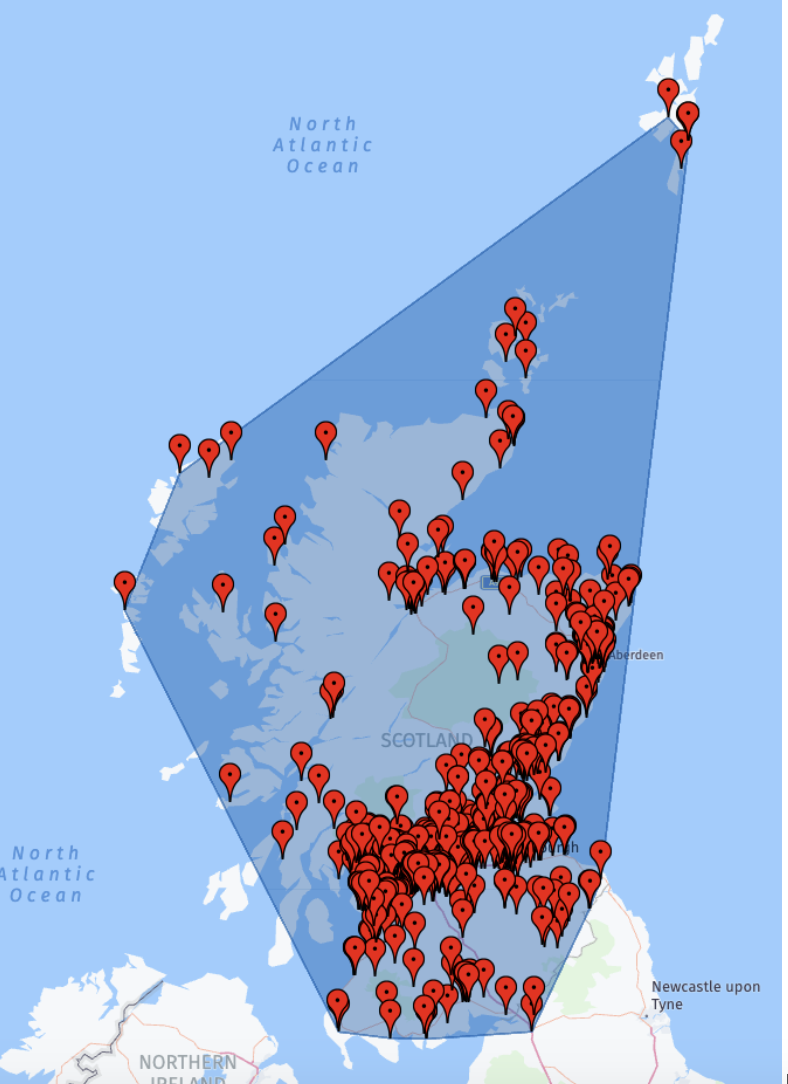
The sample set contained a lower proportion of flat owners compared to the national average (18% compared to 36%).
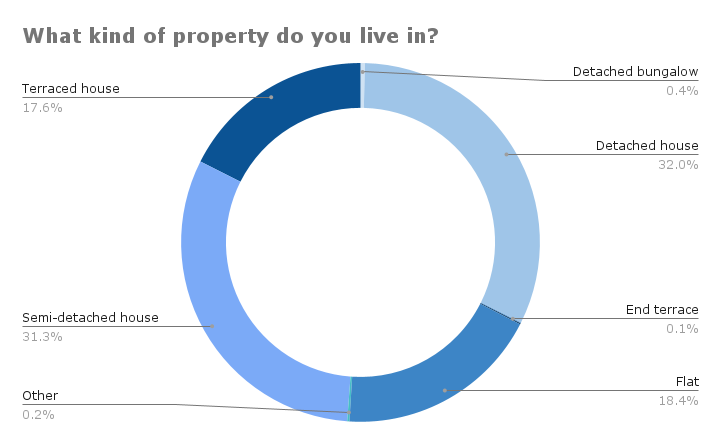
First, we asked respondents what was the main thing motivating their thinking about retrofit.
Unsurprisingly, the cost of living was ultimately the key concern for most, although purely environmental concerns still made up a strong minority of respondents.
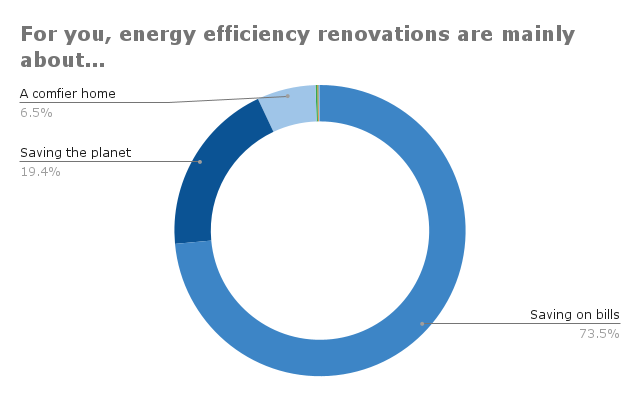
Then, we wanted to get a sense of the respondents’ sense of education about various measures by asking them if they knew what energy upgrade they could benefit from. Only a third professed to not know much about what could be done, which suggests that messages about clean energy and retrofitting are cutting through to Scottish homeowners.
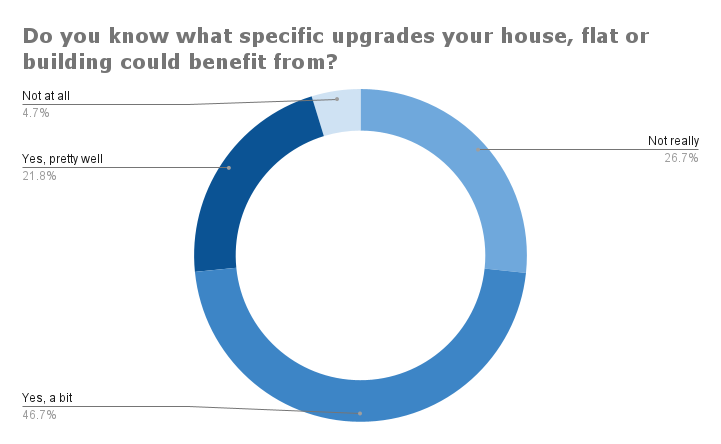
To dig into this further, we then asked what kind of upgrades they thought their building could benefit from. Respondents could include anything they wanted. Here is a breakdown of the specific measures they came up with:
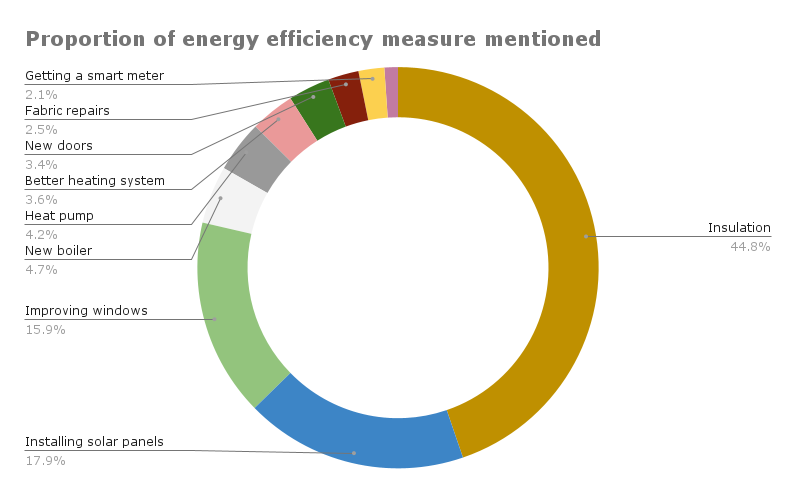
Insulation, solar panels and windows work seem to benefit from the highest notoriety. Within “insulation”, “loft/roof” insulation was the most often cited type. Heat pumps only makeup 4.2% of responses cited. Hydrogen was not cited once.
Here is the same dataset but presented in a different form, with insulation disaggregated, the count of mentions, and a longer tail.
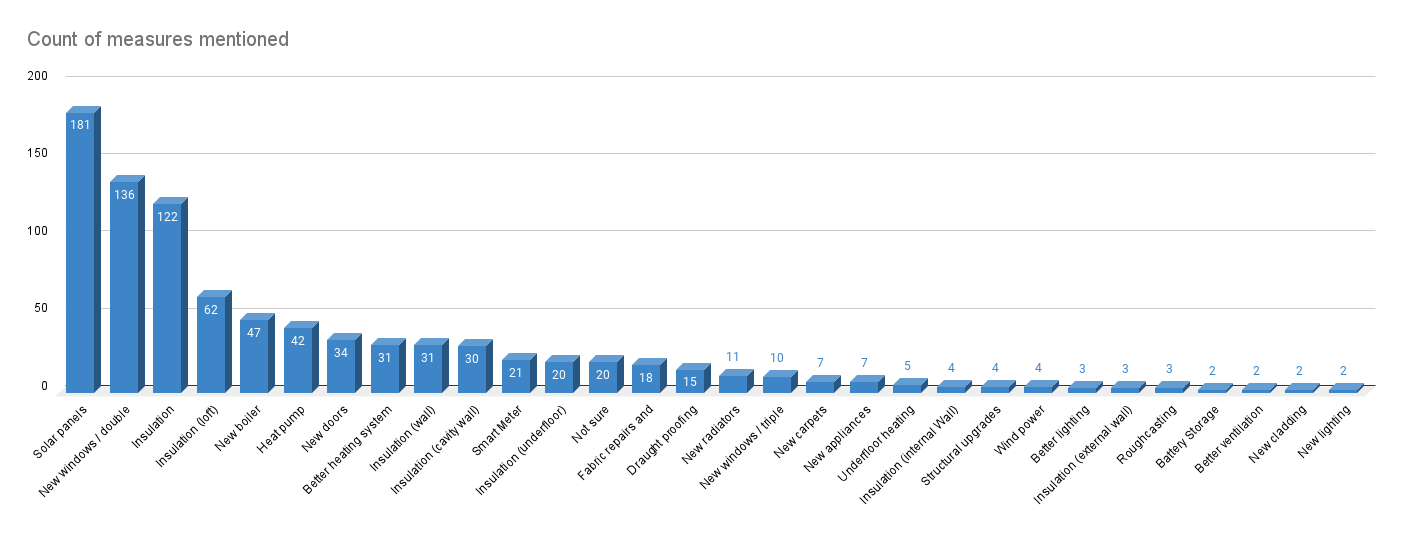
We see that although fabric repairs and maintenance is a key driver of greater energy efficiency, it was very rarely cited. It looks like there is still some way to go for the public to take a more “whole house” approach to think about their building.
Before asking some in-depth questions about the public’s progress with installing new measures so far, we wanted to know the extent to which they were comfortable with the idea of spending their own money to achieve a higher level of energy efficiency. The results were encouraging as nearly three quarters were ready to do so.
.png)
This will also likely be necessary. The latest data from NESTA suggests that the cost of retrofitting a home will come to £13,200 on average (caution: it may be significantly more or less for some properties), and some put the estimate closer to 10 or even 15% of the property’s value.
Next, we wanted to test the respondents’ market readiness. To get a sense of how far along respondents were in terms of procuring any upgrade, what they needed to do next, and what was getting in the way of achieving that.
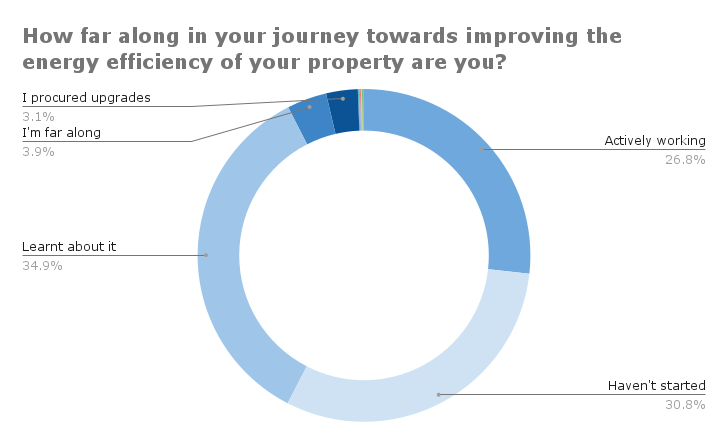
The most likely answer (12%) over all three questions was that of a homeowner who has learnt about the issues, needs to do some research, is constrained by money first and foremost.
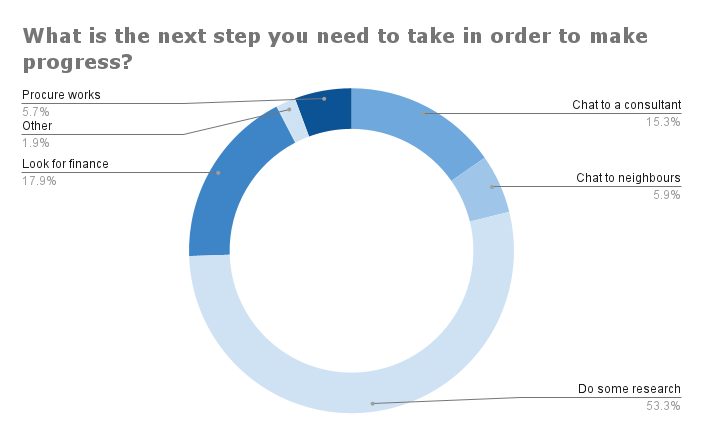
Generally speaking, it looks like the majority of respondents felt like they needed to learn more about retrofitting. 15% know they have to speak to a consultant next. A quarter of respondents were doing something about their home’s energy efficiency. But still, two thirds haven't taken any concrete step past learning more about it.
When we asked people what was getting in the way of their next step, the response was quite clear…
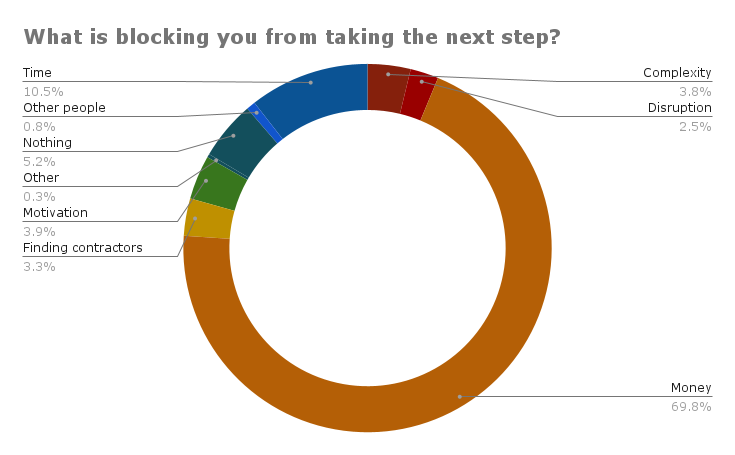
Money is obviously a critical factor. We asked people what could overcome this blocker (we removed the two thirds who replied “money” in the previous questions in order to keep the answer qualitatively relevant). They responded that a sort of end-to-end service, or at least an easy way for people to get some trusted advice, came on top of people’s likely catalysts for progressions. The need for some regulations to change (such as double glazing for tenements in conservation area properties) was occasionally mentioned.
Finally, we wanted to know if respondents would be interested in a one-stop-shop approach to retrofitting their homes, a place where information, links to contractors and consultants, eligibility checks, and financial support options could be found.
They overwhelmingly supported such an idea, with 72% seemingly on the market for a solution such as Novoville Shared Works today.
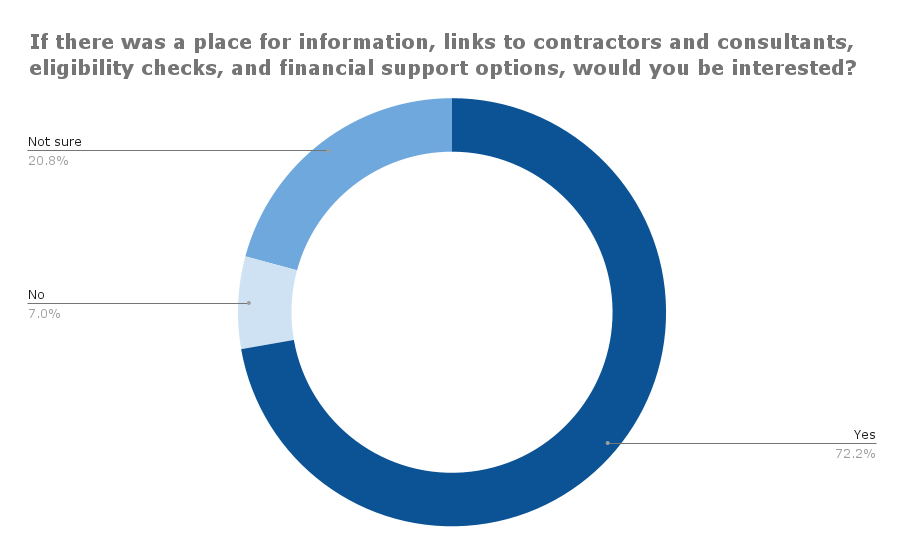
The picture that emerges from this research is that of a population which is aware of the issues, has some education about potential solutions, and is willing to move forward and invest some of its money. However, the cost of living crisis is a major hurdle to investing.
We hope that Novoville Shared Works' community powered model, with the economies of scale it creates, will help lower the upfront cost of retrofit decarbonise our nation at scale as soon as possible.

This research was conducted as part of the development of the tech company’s innovative solution to CivTech Challenge 7.7 (“How can technology help communities and households understand their energy needs and work with local suppliers towards sustainable energy solutions?”) carried out in partnership with South of Scotland enterprise. Novoville would like to thank their partners EALA Impacts , Loco Home and Everything Is User Experience for their help.
969 people took part digitally.
Respondents came from all over Scotland.

The sample set contained a lower proportion of flat owners compared to the national average (18% compared to 36%).

Here are the key results.
First, we asked respondents what was the main thing motivating their thinking about retrofit.
Unsurprisingly, the cost of living was ultimately the key concern for most, although purely environmental concerns still made up a strong minority of respondents.

Then, we wanted to get a sense of the respondents’ sense of education about various measures by asking them if they knew what energy upgrade they could benefit from. Only a third professed to not know much about what could be done, which suggests that messages about clean energy and retrofitting are cutting through to Scottish homeowners.

To dig into this further, we then asked what kind of upgrades they thought their building could benefit from. Respondents could include anything they wanted. Here is a breakdown of the specific measures they came up with:

Insulation, solar panels and windows work seem to benefit from the highest notoriety. Within “insulation”, “loft/roof” insulation was the most often cited type. Heat pumps only makeup 4.2% of responses cited. Hydrogen was not cited once.
Here is the same dataset but presented in a different form, with insulation disaggregated, the count of mentions, and a longer tail.

We see that although fabric repairs and maintenance is a key driver of greater energy efficiency, it was very rarely cited. It looks like there is still some way to go for the public to take a more “whole house” approach to think about their building.
Before asking some in-depth questions about the public’s progress with installing new measures so far, we wanted to know the extent to which they were comfortable with the idea of spending their own money to achieve a higher level of energy efficiency. The results were encouraging as nearly three quarters were ready to do so.
.png)
This will also likely be necessary. The latest data from NESTA suggests that the cost of retrofitting a home will come to £13,200 on average (caution: it may be significantly more or less for some properties), and some put the estimate closer to 10 or even 15% of the property’s value.
Next, we wanted to test the respondents’ market readiness. To get a sense of how far along respondents were in terms of procuring any upgrade, what they needed to do next, and what was getting in the way of achieving that.

The most likely answer (12%) over all three questions was that of a homeowner who has learnt about the issues, needs to do some research, is constrained by money first and foremost.

Generally speaking, it looks like the majority of respondents felt like they needed to learn more about retrofitting. 15% know they have to speak to a consultant next. A quarter of respondents were doing something about their home’s energy efficiency. But still, two thirds haven't taken any concrete step past learning more about it.
When we asked people what was getting in the way of their next step, the response was quite clear…

Money is obviously a critical factor. We asked people what could overcome this blocker (we removed the two thirds who replied “money” in the previous questions in order to keep the answer qualitatively relevant). They responded that a sort of end-to-end service, or at least an easy way for people to get some trusted advice, came on top of people’s likely catalysts for progressions. The need for some regulations to change (such as double glazing for tenements in conservation area properties) was occasionally mentioned.
Finally, we wanted to know if respondents would be interested in a one-stop-shop approach to retrofitting their homes, a place where information, links to contractors and consultants, eligibility checks, and financial support options could be found.
They overwhelmingly supported such an idea, with 72% seemingly on the market for a solution such as Novoville Shared Works today.

The picture that emerges from this research is that of a population which is aware of the issues, has some education about potential solutions, and is willing to move forward and invest some of its money. However, the cost of living crisis is a major hurdle to investing.
We hope that Novoville Shared Works' community powered model, with the economies of scale it creates, will help lower the upfront cost of retrofit decarbonise our nation at scale as soon as possible.



